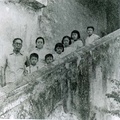Read Part 11 >>
ALIEN LAND LAWS
In an attempt to drive the Japanese out of agriculture, California had passed the first Alien Land Law in 1913 aimed specifically at the Japanese. The Law prohibited “aliens ineligible to citizenship” and companies with a majority of Japanese stockholders from purchasing agricultural land or bequeathing or selling already owned agricultural land to a fellow immigrant. The law also restricted land leases to a period of three years.
An Issei man from Cortez, California explained how he and others managed to circumvent the alien land law: “The late Mr. Caudwell,1 a lawyer made a suggestion that if we buy land in the name of Nisei children then it was possible for us to buy land. Nisei were citizens and they had a right to do so. So each family became a corporation and each child owned stock of the family land, and parents were workers for them . . . that’s how we were able to buy land.”2
Yo Yamashita put his land in his son’s name and found himself “in dire distress” because of the lawyer’s fee. “Every day was insecure like this,” he recalled, “and whenever we had unfamiliar white visitors, I was scared to death suspecting that they might have come to in investigate our land.”3
The Alien Land Law successfully disheartened farmers like Riishi Satow and his brother. “It was then impossible for us to continue farm work, not being able to own land, to work on a farm, to do anything with crops, nothing . . . We then decided that we couldn’t put any hope in the future in California, so we made up our minds to go to Oregon.”4
Though California’s 1913 Alien Land Law did manage to discourage many farmers from making longer term commitments, the acreage of owned land rose sharply, aided by World War I and the expansion of agriculture.
In 1920, anti-Japanese forces were successful in securing an amended Alien Land Law which closed the loopholes of the first law. Now leasing was completely abolished and land could no longer be legally held by a native-born minor. Senator James Phelan, who was running for reelection, made his campaign slogan: “KEEP CALIFORNIA WHITE.” The Issei farmers responded: “KEEP CALIFORNIA GREEN.” Within the next ten years, thirteen more states passed similar laws to discourage Japanese settlement.5
Sweat of pioneers
Turned these wide wilderness fields
Into fertile land,
All the while deep injuries
And insults were endured.6
The motives behind the Alien Land Law were clear: to eliminate Japanese economic competition and to discourage further immigration. Both aims were accomplished. The total acreage holdings by Japanese dropped from 458,056 acres in 1920 to 307,966 acres in 1925. And in 1924, further immigration from Japan was prohibited.
The racist intent of the Alien Land Law was clear. As Chester Rowell, editor of the Fresno Republican wrote in his correspondence to Governor Hiram Johnson: “The law must be passed ultimately, if California is not to be Hawaiianized.”7 Rowell was referring to the situation in Hawaii where 43 percent of the population was Japanese in 1920. If the law prohibited the Japanese from acquiring land, they would not immigrate in large numbers and stay, reasoned State Attorney General Ulysses S. Webb.
George Shima and other members of the Japanese community appealed to the people of California. “We live here,” Shima emphasized. “We have cast our lot with California. We are drifting farther and farther away from the traditions and ideas of our native country. Our sons and daughters do not know them at all. They regard America as their home.”8
In California and Washington, Issei contested the constitutionality of the alien land laws but to no avail. On November 12 and 19, 1923, the Supreme Court decision upheld their constitutionality destroying the economic foundation of the Japanese immigration society.
An Issei farmer in O’Brian, Washington testified, “the Anti-Japanese Land Act . . has shaken the happiness of our homes to their foundations. As the lease of my pasture expires next year and the law prohibits renewing it, we shall have to leave the farm next spring . . . I don’t know how to earn a living after next year . . . I worry day and night as to where I can find security in my old age.”9
The Rafu Shimpo reported the dejected spirit of the Issei after the Supreme Court’s decision:
Some people are thinking of returning to Japan. Some are seeking safe havens outside the state or country. Some are planning to change occupations despite lack of experience . . . Businessmen who deal in agricultural produce and marry merchants who have had farmers as their main customers have also been affected drastically.10
The obstacles that the Issei met in agriculture led an increasing number into fishing. But in this industry as well, Japanese were faced with anti-Japanese legislation and many were forced to give up fishing. Between 1919 and 1945, approximately 26 bills were introduced in the California legislature to prohibit “aliens ineligible to citizenship” to engage in commercial fishing.
Despite the setbacks, the majority of Issei chose to remain in California. They were undaunted by adversity. George Shima described the Issei spirit in his poem “A Plum Tree in the Snow”:
An anti-Japanese group inflicts persecution on us on one side.
Many hardships come upon me one after another.
But I am in high spirits.
I never yield to anyone or to anything.
As a plum tree branch never breaks even under snow.11
ACHIEVEMENTS IN AGRICULTURE
The achievements of the Issei in agriculture undoubtedly played a major part in the growing animosity. In 1920, Japanese farms produced approximately 10 percent of the total value of California’s crops valued at 67 million.
Colonel John P. Irish, president of the California Delta Association, reported to Governor William Stevens:
They (the Californians) had seen the Japanese convert barren land like at Florin and Livingston into productive and profitable fields, orchards and vineyards, by the persistence and intelligence of their industry. They had seen the hardpan and goose lands in the Sacramento Valley, gray and black with our two destructive alkalis.cursed with barrenness like the fig tree of Bethany, and not worth paying taxes on, until (K.) Ikeda, the Japanese, decided that those lands would raise rice. After years of persistent toil, enduring heartbreaking losses and disappointments, he conquered that rebellious soil and raised the first commercial crop of rice in California.12
The contributions made by the Issei in agriculture are perhaps best summarized by historian Masakazu Iwata:
(First) they filled the farm labor vacuum and thus prevented a ruinous slump. . . (Then) as independent farm operators, the Japanese with their skill and energy helped to reclaim and improve thousands of acres of worthless lands throughout the State, lands which the white man abhorred, and made them fertile and immensely productive. They pioneered the rice industry, and planted the first citrus orchards in the hog wallow lands in the San Joaquin Valley. They played a vital part in establishing the present system of marketing fruits and vegetables, especially Los Angeles County, and dominated the field of commercial truck crops. From the perspective of history, it is evident that the contributions of the Issei. . .were undeniably a significant factor in making California one of the greatest farming states in the nation.13
Deserts to farmlands…
Japanese- American
Page in history.14
Notes:
1. We believe he is referring to Guy Calden, a San Francisco attorney who helped the Issei with laws affecting the Japanese.
2. Anonymous, Michiyo Laing et al., (Eds.), Issei Christians, pp. 227.
3. Yo Yamashita, Ito, Issei, p.491.
4. Riishi Satow, Michiyo Laiing et al. (Eds), Issei Christians, pp. 34-35.
5. These states were: Arizona, Idaho, Oregon, Kansas, Louisiana, Minnesota, Missouri, Montana, Nevada, New Mexico, Texas, Washington, and Wyoming.
6. Katsuko Hirato, Ito, Issei, p. 491.
7. In Ronald Takaki, Strangers from a Different Shore, p. 204.
8. E.G.Mears, Resident Orientals on the American Pacific Coast: Their Legal and Economic Status, in Paul Jacobs and Saul Landau with Eve Pell, To Serve the Devil; Vol. 2; Colonials and Sojourners (New York, 1971), p. 231.
9. John Isao Nishinoiri, Japanese Farms in Washington, pp. 41-42.
10. Rafu Shimpo, November 27, 1923, in Ichioka, The Issei, p. 233.
11. Toshio Yoshimura, George Shima; Potato King and Lover of Chinese Classics (Japan, 1981), p. 42.
12. “Interview with Mr. S.Nita,” 1924, p. 2, Survey of Race Relations, Stanford University, Hoover Institution Archives, in Ronald Takaki, Strangers from a Different Shore, p. 191-192.
13. Masukazu Iwata, “The Japanese immigrants in California Agriculture,” Agricultural History, Vol. 36, No. 1 (1962), pp. 25-37.
14. Isshin, Ito, Issei, p. 493.
* Issei Pioneers: Hawai‘i and the Mainland, 1885-1924 is the catalogue accompanying the National Museum’s inaugural exhibition. Using artifacts from the National Museum’s collection to tell the story of the courageous “Issei Pioneers,” the catalogue focuses on the early immigration and settlement years. To order the catalogue >>
© 1992 Japanese American National Museum





